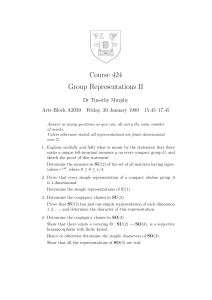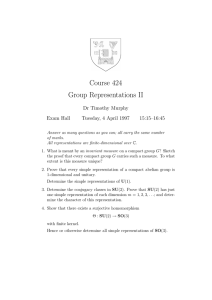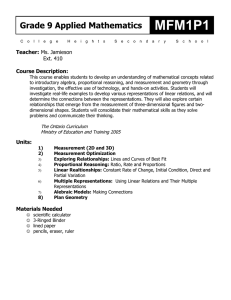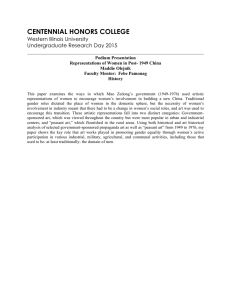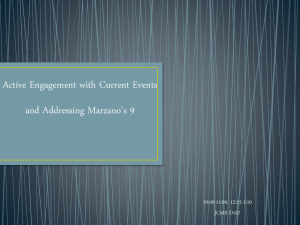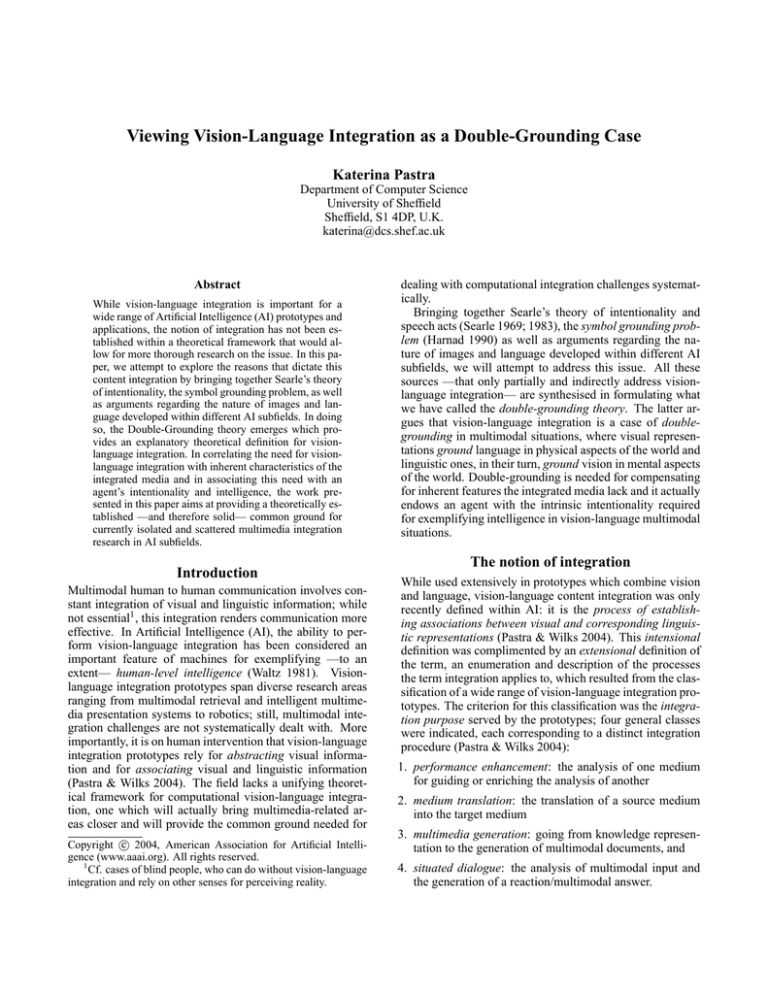
Viewing Vision-Language Integration as a Double-Grounding Case
Katerina Pastra
Department of Computer Science
University of Sheffield
Sheffield, S1 4DP, U.K.
katerina@dcs.shef.ac.uk
Abstract
While vision-language integration is important for a
wide range of Artificial Intelligence (AI) prototypes and
applications, the notion of integration has not been established within a theoretical framework that would allow for more thorough research on the issue. In this paper, we attempt to explore the reasons that dictate this
content integration by bringing together Searle’s theory
of intentionality, the symbol grounding problem, as well
as arguments regarding the nature of images and language developed within different AI subfields. In doing
so, the Double-Grounding theory emerges which provides an explanatory theoretical definition for visionlanguage integration. In correlating the need for visionlanguage integration with inherent characteristics of the
integrated media and in associating this need with an
agent’s intentionality and intelligence, the work presented in this paper aims at providing a theoretically established —and therefore solid— common ground for
currently isolated and scattered multimedia integration
research in AI subfields.
Introduction
Multimodal human to human communication involves constant integration of visual and linguistic information; while
not essential1 , this integration renders communication more
effective. In Artificial Intelligence (AI), the ability to perform vision-language integration has been considered an
important feature of machines for exemplifying —to an
extent— human-level intelligence (Waltz 1981). Visionlanguage integration prototypes span diverse research areas
ranging from multimodal retrieval and intelligent multimedia presentation systems to robotics; still, multimodal integration challenges are not systematically dealt with. More
importantly, it is on human intervention that vision-language
integration prototypes rely for abstracting visual information and for associating visual and linguistic information
(Pastra & Wilks 2004). The field lacks a unifying theoretical framework for computational vision-language integration, one which will actually bring multimedia-related areas closer and will provide the common ground needed for
c 2004, American Association for Artificial IntelliCopyright gence (www.aaai.org). All rights reserved.
1
Cf. cases of blind people, who can do without vision-language
integration and rely on other senses for perceiving reality.
dealing with computational integration challenges systematically.
Bringing together Searle’s theory of intentionality and
speech acts (Searle 1969; 1983), the symbol grounding problem (Harnad 1990) as well as arguments regarding the nature of images and language developed within different AI
subfields, we will attempt to address this issue. All these
sources —that only partially and indirectly address visionlanguage integration— are synthesised in formulating what
we have called the double-grounding theory. The latter argues that vision-language integration is a case of doublegrounding in multimodal situations, where visual representations ground language in physical aspects of the world and
linguistic ones, in their turn, ground vision in mental aspects
of the world. Double-grounding is needed for compensating
for inherent features the integrated media lack and it actually
endows an agent with the intrinsic intentionality required
for exemplifying intelligence in vision-language multimodal
situations.
The notion of integration
While used extensively in prototypes which combine vision
and language, vision-language content integration was only
recently defined within AI: it is the process of establishing associations between visual and corresponding linguistic representations (Pastra & Wilks 2004). This intensional
definition was complimented by an extensional definition of
the term, an enumeration and description of the processes
the term integration applies to, which resulted from the classification of a wide range of vision-language integration prototypes. The criterion for this classification was the integration purpose served by the prototypes; four general classes
were indicated, each corresponding to a distinct integration
procedure (Pastra & Wilks 2004):
1. performance enhancement: the analysis of one medium
for guiding or enriching the analysis of another
2. medium translation: the translation of a source medium
into the target medium
3. multimedia generation: going from knowledge representation to the generation of multimodal documents, and
4. situated dialogue: the analysis of multimodal input and
the generation of a reaction/multimodal answer.
However, while this descriptive definition sheds some light
on the issue of integration, it does not actually provide any
justification of why computational vision-language integration is needed. An indirect justification found within imagelanguage interaction corpus-based studies is that interaction
(which is served through integration) serves communicative
goals, it establishes coherence in multimodal communication (André & Rist 1993). However, what does coherence in
vision-language multimodal situations actually mean, what
is it that each of the modalities involved lacks, that justifies
the need for integration? In other words, what does language
need from vision and what does it offer to vision in its turn?
We believe that looking at the inherent characteristics of the
integrated modalities might hold a more elaborate answer to
this question.
Figure 1: The vision process: its media and modalities
A parallel exploration of Vision and Language
In viewing vision and language as processes that make use
of modular representation systems and transformation algorithms, Marr’s influential theory of vision (Marr 1982) and
Jackendoff’s structural computational model of natural language (Jackendoff 1983), provide the common ground required for a parallel exploration of the nature of these faculties. Within these theories, images and language are described as systems of iconic and symbolic representations
respectively. They meet, therefore, through the notion of
representation; they take a form and have a meaning. Both
the visual and the linguistic representations stand for a reference object which may be a mental (conceptual) entity
or/and a physical one. Leaving analogies and other differences aside, differences in the nature of the reference object
they can stand for emerge from such a parallel exploration.
In particular, the reference of a visual representation may
be a physical object or scene whose mere existence triggers the vision generation process (visual perception). The
goal to infer (or even go beyond) this reference object (literal meaning) drives the recognition process (image understanding). When the vision process is triggered by a mental
representation (concept), then one crosses over into visualisation. In this case, images actually transform the status
of their reference object from mental into physical, so that
one cannot tell for sure —by looking at the image alone—
whether the object depicted is a physically existing entity or
whether it stands as a visual example of a general class of
entities. Figure 1 illustrates this view of vision.
On the other hand, the input to the language generation
process is a mental representation (conceptualisation) whose
levels of abstraction or genericness can be perfectly conveyed by the linguistic representations. While language retains the non-physical status of its input, it has no access to
the physical world. It can only indirectly refer to specific
instances of physical objects (through e.g. proper names,
deictic references etc.), relying on the use of perceptual processes for a direct access to these objects. Figure 2 illustrates
this view of language.
Inherent media characteristics
Language has been characterised as general (Bernsen 1995):
it goes beyond things that can be depicted to abstract ideas
Figure 2: Language as a process: its media and modalities
and reasoning. Furthermore, it has subtle mechanisms for
controlling attendance to details or focus (Minsky 1986;
Bernsen 1995). On the contrary, images are specific, i.e.,
they are exhaustive representations of what they stand for,
(providing, for example, direct measurements of the entities
depicted). In addition, they have no inherent means for efficiently indicating the focus (Bernsen 1995) and salience
of what they depict. In fact, images which result from visual
perception representations have no mechanisms of their own
for indicating such aspects2 ; this characteristic of vision has
led researchers to the inclusion of indexical-deictic mechanisms in computer vision theories (Ballard et al. 1997).
This way, the generation of visual representations of all
the positions and properties of all the objects depicted in
a visual scene is avoided and instead, indication of the focus and salience intended is achieved3 . In its turn, images
which result from visualisation have some limited mechanisms for indicating focus and salience (e.g. through highlighting, use of pointing arrows etc.) (André & Rist 1993;
Bernsen 1995); still, a very accurate and efficient metalanguage for expressing such information is missing4 .
2
It is fixation and its neural analogue (attention) which indicate
focus in visual perception (Ballard et al. 1997).
3
Cf. also a cognitive theory of vision in (Pylyshyn 2001).
4
In mono-modal situations, the context of images gives clues
for inferring such information; still, no direct, explicit, indication
Furthermore, both visual perception and visualisation representations are very specific in nature, they always depict
individual tokens, even when the intention of the agent who
generates these representations may be to express a representative of a class of objects, a representative of a specific level of abstraction (e.g. a dinner table standing as
an example of “domestic furniture”). It has been argued
that token:type distinctions cannot actually be indicated by
visual representations (Jackendoff 1987); though this view
has been recently challenged (Barsalou et al. 2003), placing
something depicted to the appropriate level in a rich conceptual system has not been proven feasible with visual mechanisms alone. In both cases of focus/salience and token:type
distinctions, visual representations require ways of precisely
indicating the intentions of the agent who generates the visual representations. A fine-grained meta-linguistic function
—inherently lacking in visual representations— is required
to indicate intentional aspects of what is depicted.
Therefore, while both vision and language can express
mental entities (concepts), vision has in this case no way to
retain the mental/abstract character of what it depicts, which
is due to its specificity and lack of effective focus/salience
indication means. It lacks control over the focus and level
of abstraction of what it expresses. In its turn, language is
never triggered by the existence of a physical object as vision is; it can only indirectly refer to something that exists
in the physical world, due to the always conceptual, mental
character of its input. There seems to be an intentionality issue here: some aspects of intentionality cannot be expressed
by visual modalities effectively and require the use of highly
expressive indicators; on the other hand, intentional content
referring to specific physical entities relies on perceptual (visual) modalities when expressed through language. We turn
to Searle’s intentionality theory for exploring this further.
Searle on visual and linguistic representations
A close look into Searle’s theory of speech acts (Searle
1969) reveals an intimate relation between language and perception —and therefore visual perception— in many cases.
In particular, in the case of assertives, an “independently existing reality” is supposed to be matched5 , which actually
presupposes that this reality is somehow accessed/known by
the agent who makes use of the assertive. Access to this reality enables the agent to check whether the conditions of
satisfaction of what (s)he expresses through the assertive are
met or not. The example case par excellence is the one of the
indexicals (e.g. demonstratives), which require —according
to Searle— visual perception of what is referred to6 . While
the other types of speech acts (excluding expressives) impose changes to the world, rather than describing its state
of affairs, they are —by nature— causally unconnected to
the physical world too7 . Given the fact that an agent needs
to know whether the conditions of satisfaction of what (s)he
of this information through visual means can be provided.
5
Cf. pp. 173 in (Searle 1983).
6
Cf. pp. 218-230 in (Searle 1983).
7
Cf. pp. 173 in (Searle 1983).
expresses are met or not8 , a direct access to the world they
act upon is required in their case too. Contrary to linguistic
representations which have no intrinsic causal relation with
the world, visual representations are caused by the state of
affairs they represent and can, indeed, give a “direct access”
to this physical world that invokes them9 .
So, Searle’s theory indicates not only a “lack of direct
access to the physical world” that linguistic representations have, but also an inherent need on the part of linguistic representations, for such an access. Visual perception representations are shown to be able to assist language
in compensating for this. However, Searle does not refer to visualisation at all. Do visual representations that
stand for a conceptual reference object (and have therefore not been invoked by a physical entity/scene) provide
such an access to language too? Although Searle does not
address this issue, some extensions to his theory actually
do. Drawing an analogy to speech acts, the notion of pictorial acts (Kjorup 1978; Maybury 1993) has been introduced for indicating the double-level of intentionality expressed through visualisation representations. So, Searle’s
theory refers to both linguistic speech acts (Searle 1969;
1976) and visual perception representations and some of its
extensions have also addressed the visualisation issue. This
is one of the reasons we chose this specific philosophical
theory of intentionality. The second reason is that Searle
has criticised AI symbol systems for being non-intentional
and has linked, therefore, his intentionality theory to AI research, AI also being the perspective from which we explore
integration in this paper.
The symbol grounding problem
In Searle’s well-known Chinese-room argument10 , it is being argued that AI symbol systems lack the intentionality
required for being artificial minds (Searle 1980). Searle
argued that it is intrinsic intentionality —as opposed to
human-derived one— that is required on the part of the system for the latter to demonstrate human-level intelligence.
The main point was that AI systems consist of programs
with formal symbols (encoding), whose meaning is obvious
only to humans and not the systems themselves; the artificial mind does not impose intentionality on them, it is rather
the human developer who does so. Though computer programs consist of artificial language symbols that encode e.g.
linguistic or visual representations (natural language words,
visual objects etc.), the meaning of this encoding and the one
of the representations themselves resides in humans’ mind.
The system can manipulate the encoding syntactically, but it
8
This is required —according to Searle— for attributing real
intentionality to an agent, cf. pp. 177 in (Searle 1983).
9
Cf. pp. 46 in (Searle 1983).
10
The argument that a human getting input in Chinese and following strict instructions on the manipulation of such symbolic
representations can generate native-quality Chinese output with
no actual knowledge and understanding of Chinese; Searle argues
that similarly, artificial systems able to analyse natural language
and generate linguistic output exemplify no real understanding, because they lack intentionality (Searle 1980).
has no idea what the encoding stands for (semantic interpretation) or what the representations encoded actually mean
(what a specific word refers to, or what a visual object looks
like).
Therefore, mere instantiation of a program, even if it resulted in perfectly structured and coherent output, would not
reveal any intentionality on the part of the system (Searle
1980). In other words, Searle accused AI systems, of failing
to express intentionality in their simulation of mental states
(such as understanding), due to their inability to impose —
on their own— meaning on the symbols they used. However, what is required from a mind in order to be ascribed
intrinsic intentionality and, therefore, human-level intelligence?
The prevailing solution suggested for this problem was
the bottom-up grounding of symbolic representations to perceptual ones that provide a causal link to the world; knowing this link is what Searle has required for attributing intentionality to agents. In answering to Searle’s criticisms
of AI systems, the need for grounding linguistic representations to perceptual ones has been advocated within the socalled symbol grounding problem (Harnad 1990). The latter
is interested in computational techniques for grounding the
meaning of symbolic representations (such as the linguistic ones) to non-symbolic ones. Hybrid systems making use
of both symbolic and connectionist techniques for learning
the link between linguistic symbols and their physical (nonsymbolic) visual references have been suggested (Harnad
1990; Cangelosi, Greco, & Harnad 2000), as well as pure
connectionist techniques (Jackson & Sharkey 1996). Recent cutting-edge research on machine learning algorithms
for teaching an agent how to name visual objects is an
empirical follow-up of this symbol grounding related literature (Kaplan 2000; Roy & Pentland 2000; Roy 2002;
Bredeche et al. 2003; Vogt 2003).
Symbol grounding has been addressed in AI from positions of wider or narrower scope (cf. for example work by
Ziemke 1997 and Vogt 2002). Parts of the symbol grounding problem have even emerged as AI research sub-fields on
their own right; anchoring, for example, has been recently
described as a new challenge in robotics (Coradeschi & Saffiotti 2003)11 . In all its manifestations though, the symbol
grounding debate has focused on lower or higher representation levels in AI systems.
While Searle’s arguments were targeted originally against
AI symbol system programs as realised through formal symbols/encoding/artificial language symbols, the illustration of
his claims through the Chinese-room argument shifted the
debate to natural language symbolic representations in general12 . Subsequently, natural language understanding as an
intentional state exemplified through natural language generation has monopolised the debate as the grounding case
11
The anchoring problem involves artificial agents establishing
and maintaining correspondences between the ID/names of individual physical objects and their corresponding visual percepts.
12
This is justified by the fact that AI and natural language symbolic representations have been found to be alike; cf. for example
an extensive debate on this in (Nirenburg & Wilks 2001).
par excellence in Searle’s arguments. All symbol grounding
computational solutions suggested followed the same direction and referred, therefore, to ways of developing causal relations between natural language and corresponding visual
percepts through bottom-up grounding.
It seems that symbol grounding —as treated in the literature so far— is characterised by a predominant bottom-up
direction, i.e., it focuses on the grounding of natural language symbolic representations in visual perception ones, a
grounding that provides linguistic representations with the
direct access to the physical world they inherently lack.
What about visualisation representations though? Do they
ground linguistic representations too? More importantly,
could it be that the nature of the grounding process is bidirectional, rather than one-directional?
The Double-Grounding Theory
In this section, we attempt to address the above mentioned
questions, which leads us to the formulation of the doublegrounding theory.
Visual grounding of language in the physical world
Figure 3 illustrates symbol grounding as traditionally advocated in AI research. The figure presents the physical world
and the mental world; no Cartesian dichotomy between the
two is implied though. We follow Searle’s perception of the
world as consisting of physically existing entities (the outside reality) and mental entities (an agent’s inside reality)
(Searle 1983). Visual and linguistic representations stand
in between, since though they are mental, they can also be
physically realised (cf. notion of modalities). Visual perception representations have a direct access to the physical
world, since their generation is triggered by physical entities. In their turn, linguistic representations are triggered
by mental entities (and therefore have a direct access to the
mental world). When associated to visual perception representations, they get grounded in the physical world, i.e., they
acquire a direct access to physical referents. Can the same
access be provided to language by visualisation representations though?
As mentioned earlier, some researchers have drawn a parallel to speech acts for describing intentionality in visualisation (Kjorup 1978; Maybury 1993). Similarly to speech
acts, pictorial acts are not invoked causally by physical entities. This is an important similarity they share with linguistic
representations. The similarity points —logically— to the
fact that visualisation representations lack and need access
to the physical world, exactly as linguistic representations
do. However, a basic difference in the nature of these two
affects this need greatly: visualisation representations are
not always (and merely) symbolic, as language is; they are
iconic in nature and therefore, resemble —more or less—
the physical world. Some of them are highly realistic/iconic,
others are more symbolic13 .
13
Even highly symbolic images e.g. a pie chart presenting the
results of an election-related exit poll, has iconicity; it has been
chosen from among other information graphics types for its iconic
properties.
two cases of grounding linguistic representations through
grounded or/and ungrounded realistic visualisations.
Figure 3: Visual perception representations ground language
in the physical world
In the first case, physical resemblance to the world is a
safe criterion for associating the images to visual perception
representations of the physical world, while in the case of
highly symbolic images this association is conventional (as
in the case of language). Visual perception representations
can ground both symbolic and realistic visualisation representations. The difference in these two groundings lying in
the types of associations needed. Symbolic images (e.g. a
rectangle standing for a vehicle in a route diagram) require
a learned/imposed association, while realistic images (e.g. a
portrait) map directly to corresponding visual perceptions.
While grounded visualisation representations can ground
—in their turn— language too, their nature is such that even
when ungrounded themselves, they attempt to ground linguistic representations in the physical world or —to be more
precise— to the intended physical world. This is so, because even when realistic visualisations express something
mental, they give a believable physical appearance to it, so
that the viewer cannot tell —by looking at the image alone—
whether the image resulted from visual perception or visualisation. In this case, visualisation transforms a mental
entity into a physically looking one; if used to ground linguistic/symbolic representations, it provides access to (an
AS IF) THE physical world which is intended (by the agent
who generates the visualisation) to be thought of as THE
physical world, in a specific communication context. For
example, photo-realistic three-dimensional graphics depicting what the interior of a house will look like, when its
renovation is complete, provide the corresponding linguistic description of the house with a direct access to (an AS
IF) THE physical world; the latter, is not the visually perceptible physical world, since it depicts a future state of affairs, but within the specific communication context, it is
supposed to be THE physical world of interest, in which the
linguistic discourse needs to be grounded. It is in this sense,
that realistic visualisations can provide linguistic representations with a direct access to the physical world, no matter
whether themselves grounded or not. Figure 4 illustrates the
Figure 4: Realistic visualisations ground language in the
physical world
Based on all the above, we argue that visual representations in general —i.e., visual perception, grounded symbolic visualisations and grounded or ungrounded realistic
visualisations— provide linguistic representations with a direct access to the physical world, i.e., they ground language
in the physical world. This takes place through association
and it is an important ability for artificial systems, if the systems are to be ascribed intrinsic intentionality.
Linguistic grounding of visual representations in
the mental world
The very same characteristic of visual representations which
provides a direct access to the physical world, i.e., being always specific, has further implications though, which
are related to their ability to indicate intentional aspects of
the content they express. While not referring to the ability of visual representations to indicate various distinctions,
Searle does stress the importance of expressing such distinctions. According to Searle’s theory, representations have —
by definition— an intentional aspect that denotes the relevance of what is expressed to a situation; its role is significant in that it points to the appropriate background capacities
and knowledge needed for determining the conditions of satisfaction of the intentional mental states represented14 . The
Peircian semiotic theory, refers to the existence of such an
aspect too, using the term ground; the “ground” of a sign
being the idea in respect of which a representation takes
place (Peirce 1960). This aspect could denote anything that
is situation-specific, such as the time and place of the communication event, the domain/perspective from which something is approached, the register, focus/salience of what is
referred to etc.
14
Cf. pp.13 and chapter 5 in (Searle 1983).
Language is extremely efficient in making all such aspects clear (cf. theme/topic theories in linguistics, controlled
sub-languages for expressing domain of interest, phenomena of code-switching, idiolects etc.). However, can visual
representations indicate and express such intentional aspects
clearly and efficiently?
Earlier, we argued that visual representations lack inherent ways of indicating focus/salience and type:token distinctions. Visual perception representations have no direct access to the mental world, since their generation is triggered
only by physically existing entities; in representing the mental state of visual experience though, they need to express
intentional aspects of their referents too, a task for which
they have no visual means. In their turn, visualisations have
a direct access to the mental world, since they are triggered
by mental entities, they have some mechanisms of their own
for indicating focus and salience (e.g. highlighting, zooming, pointing arrows etc.), but they have no efficient mechanisms for such a task and no mechanisms at all for indicating type:token distinctions and different levels of abstraction
in general. Since visual representations strip the intentional
content they express from any mental aspects it might contain, an agent analysing the representations cannot grasp the
intended meaning of such representations fully (relying on
visual means only). So, how could the agent who generates visual representations indicate any related intentional
aspects?
Going back to the symbol grounding problem, one could
argue that establishing vision-language associations could
play another role too; by associating visual tokens with language units one is actually able to label/annotate the visual
tokens making use of language’s expressive power in indicating subtle distinctions. Therefore, associating a visual
object with a specific word/phrase can indicate the focus of
what is depicted (by referring exactly to what is of interest,
leaving aside background visual elements) and its token or
type status and in particular its exact conceptual status (level
of abstraction - e.g. the use of a male proper name vs. the
use of the word “man” vs. the use of the word “individual”
etc.). It seems therefore, that in vision-language associations
it is not only vision that plays a significant role in grounding
language in the physical world; language, in its turn, provides the means for vision to indicate intentional aspects of
what it depicts, providing visual representations with a control over their referents, and grounding —this way— visual
representations in the mental world (since intentional content and aspect are mental entities according to Searle). In
particular, in such associations, language assists in distinguishing between cases when:
level at which they meet.
• Same visual representations for the same object are assigned different words/labels. In this case language may
denote differences in register, domain (terminology) and
level of genericness (type-token distinctions).
• Last, language assists in referring/pointing at exactly that
which is of interest/in focus in a visual representation,
leaving aside things that are necessarily depicted but are
not of interest (Vogt 2003).
• Different visual representations (because of differences in
resolution, point of view, occlusions etc.) are used to refer
to the same object (Vogt 2003). By associating the same
word to the different visual representations an agent learns
that they all refer to the same object.
The synthesis
• Different visual representations are used to refer to different objects that belong though to the same class (family
resemblance cases) (Vogt 2003). Language denotes the
class of the representations, determining the conceptual
Figure 5: Language representations ground vision in the
mental world
Therefore, we argue that language grounds visual representations in the mental world, providing them with a controlled access to mental referents and in particular, providing a way for indicating levels of abstraction, focus and relevance in what is depicted. Figure 5 illustrates this. Visual
representations have access to the mental world (visualization ones are triggered by mental entities, while perceptual
ones express the visual experience mental state); however,
they have no control over this access. They need a controlled
grounding, but they have no (or they have feeble) inherent
means of achieving it. One way of achieving this grounding
is through association of visual representations with linguistic ones.
Seen from a wider scope of grounding representations in
general (regardless of whether they are symbolic or iconic),
the grounding direction is not one- but rather bi-directional.
Natural language symbolic representations can ground visual ones too, by functioning as intentional aspect indicators.
The parallel exploration of vision and language and Searle’s
theory of intentionality have both pointed to important, inherent characteristics of visual and linguistic modalities:
• Language lacks direct access to the physical world,
whereas
• Vision lacks controlled access to the mental world (it
lacks effective ways of indicating mental aspects of the
world)
Although the former has been indicated and addressed computationally for solving the symbol grounding problem, the
latter has been largely ignored. Extending the notion of symbol grounding to representation grounding in general and indicating the bi-directionality of grounding as a process, we
argue that:
• Visual representations ground (provide direct access to)
linguistic representations in the physical world, while
• Linguistic representations, in their turn, ground visual
representations in the mental world, providing a way for
indicating degrees of abstraction, focus and relevance in
what is depicted
Figure 6 illustrates this double grounding. Association is the
sine qua non constituent of grounding in either direction. In
fact, it is what bridges the gap between the two quite different types of representations, it is bi-directional itself, and
therefore renders grounding bi-directional too.
Figure 6: Vision-Language Integration: a double grounding
case
Visual and linguistic representations need to be directly
grounded in both physical and mental aspects of the world.
Visual representations inherently need a controlled access
to the mental world, in order to indicate intentional aspects
of their physical or/and mental referents efficiently. In their
turn, linguistic representations inherently need a direct access to the physical world, in order to maintain coherence in
communication, when performing the intentionality act they
are employed to. Generally speaking, the agents who analyse or/and generate visual and linguistic representations,
need to be able to ground these representations on their own,
if they are to be ascribed intrinsic intentionality.
If associating visual and linguistic representations is the
essence of double-grounding, then, re-visiting the descriptive AI definition of vision-language integration (Pastra &
Wilks 2004) that:
“vision-language integration is the process of establishing associations between visual and linguistic pieces of
information”
leads us to the conclusion that:
“Vision-language integration is a case of doublegrounding of visual and corresponding linguistic representations.”
The conclusion provides a theoretically established explanatory justification of why integration of visual and linguistic
information takes place in multimodal situations: so that one
medium compensates for the features that the other lacks, or,
to put it generally, for serving coherence in communication.
Vision-language integration abilities allow an agent to express and understand intentionality in specific multimodal
situations15 .
At this point, we need to note that we are far from claiming that all language can be grounded in/integrated with
vision; language in many cases refers to abstract, nonperceptible entities and states of affairs. We do not claim
that language always needs grounding. Neither that it is
only vision that can ground language in the physical world16 .
Similarly, we do not claim that all images can be grounded
in/integrated with language (there are cases when one is
short of words for describing something, cf. e.g. surrealistic paintings)17 . Neither do we claim that images always
need to be grounded (communication context may clearly
indicate the intended intentional aspect that an image can’t
indicate on its own). We do not claim that it is only language
that can ground images; gestures, for example may do this
to an extend, though language is undoubtedly extremely efficient in denoting things that images can’t denote with visual
means.
We look into situations in which the content of linguistic
representations can, indeed, be associated with the content
of visual ones. We claim that in such situations, vision and
language are both used, because their integration (doublegrounding) allows the representations of one to compensate
for features the representations of the other inherently lack;
in these situations, lack of integration causes coherence gaps
in communication and is a sign of lack of intrinsic intentionality on the part of the agent involved. Which are these
situations though? When is integration needed?
In identifying four types of vision-language integration
processes, work reported in (Pastra & Wilks 2004) has also
indicated four corresponding integration purposes served
by the AI prototypes reviewed. These purposes could
be thought of as very general situations in which visionlanguage integration is a sine qua non process (as indicated
within AI, i.e., for computational purposes):
15
We need to note that our work has an AI perspective; justifying vision-language integration in humans would require a further
correlation of our theory with cognitive science related literature
which goes beyond the scope of this paper. Some preliminary correlations can be found in (Pastra & Wilks 2004).
16
Other perceptual processes could substitute vision’s role. Cf.
the case of blind people who rely on other senses, such as audition
and haptics.
17
Note, also, that we refer mainly to cases of images of objects/scenes; however, there are images of e.g. text or gestures too.
We do not address these special cases of images in this paper because of space constraints.
• when the analysis of a medium needs disambiguation
through the analysis of another medium,
• when the content of one medium needs to be expressed in
another,
• when a multimodal answer needs to be generated, or
• when situated multimodal dialogue takes place.
Conclusion
In this paper, we attempted to present an explanatory, theoretical framework for vision-language integration in AI18 .
In pointing out that this type of integration is dictated by
the inherent characteristics of visual and linguistic representations, double-grounding aims at correlating the notion of
media inter-dependence with the task of integration. Furthermore, in associating issues of intrinsic intentionality
(and intelligence) with the vision-language integration abilities of an agent, the theory emphasises the AI objective
served through computational vision-language integration.
Through both these aspects, double-grounding provides a
theoretically grounded view of collaboration between AI
subfields as a sine qua non requirement for vision-language
integration.
Acknowledgments
The author would like to thank Yorick Wilks for his valuable
comments on previous drafts of this paper. Part of this work
has been funded by the GR/M89676/01 EPSRC grant.
References
André, E., and Rist, T. 1993. The design of illustrated documents as a planning task. In Maybury, M., ed., Intelligent
Multimedia Interfaces. AAAI Press/MIT Press. chapter 4,
94–116.
Ballard, D.; Hayhoe, M.; Pook, P.; and Rao, R. 1997. Deictic codes for the embodiment of cognition. Behavioral
and Brain Sciences 20(4):723–767.
Barsalou, L.; Simmons, W.; Barbey, A.; and Wilson,
C. 2003. Grounding conceptual knowledge in modalityspecific systems. Trends in Cognitive Sciences 7(2):84–91.
Bernsen, N. 1995. Why are analogue graphics and natural
language both needed in HCI? In Paterno, F., ed., Interactive Systems: Design, specification and verification. Focus
on Computer Graphics. Springer Verlag. 235–251.
Bredeche, N.; Chevaleyre, Y.; Zucker, J.; Drogoul, A.; and
Sabah, G. 2003. A meta-learning approach to ground symbols from visual percepts. Robotics and Autonomous Systems 43:149–162.
Cangelosi, A.; Greco, A.; and Harnad, S. 2000. From
robotic toil to symbolic theft: Grounding transfer from
entry-level to higher-level categories. Connection Science
12:143–162.
18
The theory is part of a larger investigation of vision-language
integration in AI, which also includes empirical work on testing the limits of current AI technology for performing visionlanguage integration, minimising human intervention in core integration stages.
Coradeschi, S., and Saffiotti, A. 2003. An introduction to
the anchoring problem. Robotics and Autonomous Systems
43:85–96.
Harnad, S. 1990. The Symbol grounding problem. Physica
D 42:335–346.
Jackendoff, R. 1983. Semantics and Cognition. MIT Press.
Jackendoff, R. 1987. On beyond Zebra: the relation of
linguistic and visual information. Cognition 20:89–114.
Jackson, S., and Sharkey, N. 1996. Grounding computational engines. Artificial Intelligence Review 10:65–82.
Kaplan, F. 2000. Talking AIBO: First Experimentation
of Verbal Interactions with an Autonomous Four-legged
Robot. In Proceedings of the TWENTE Workshop on Language Technology, 57–63.
Kjorup, S. 1978. Pictorial Speech Acts. Erkenntnis 12:55–
71.
Marr, D. 1982. Vision. San Francisco: W. H. Freeman.
Maybury, M., ed. 1993. Intelligent Multimedia Interfaces.
AAAI Press/MIT Press.
Minsky, M. 1986. The Society of Mind. Simon and Schuster Inc.
Nirenburg, S., and Wilks, Y. 2001. What’s in a symbol:
ontology, representation and language. Journal of Experimental and Theoretical Artificial Intelligence 13(1):9–23.
Pastra, K., and Wilks, Y. 2004. Vision-Language Integration in AI: a reality check. In Proceedings of the 16th
European Conference on Artificial Intelligence.
Peirce, C. 1960. Collected Papers of Charles Sanders
Peirce, volume 1 and 2. Belknap Press of Harvard University Press.
Pylyshyn, Z. 2001. Visual indexes, preconceptual objects,
and situated vision. Cognition 80:127–158.
Roy, D., and Pentland, A. 2000. Learning Words from
Sights and Sounds: A computational model. Cognitive Science 26(1):113–146.
Roy, D. 2002. Learning visually grounded words and syntax for a scene description task. Computer speech and language 16:353–385.
Searle, J. 1969. Speech acts: an essay in the philosophy of
language. Cambridge University Press.
Searle, J. 1976. A classification of illocutionary acts. Language in Society 5(1):1–23.
Searle, J. 1980. Minds, Brains, and programs. Behavioral
and Brain Sciences 3(3):417–457.
Searle, J. 1983. Intentionality: an essay in the philosophy
of mind. Cambridge University Press.
Vogt, P. 2003. Anchoring of semiotic symbols. Robotics
and Autonomous Systems 43(2):109–120.
Waltz, D. 1981. Generating and understanding scene descriptions. In Joshi, A.; Webber, B.; and Sag, I., eds., Elements of discourse understanding. Cambridge University
Press. 266–282.


